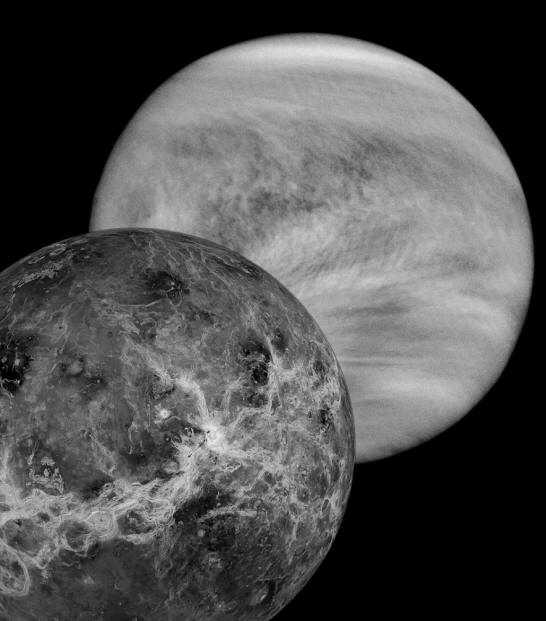|

Venus in radar wavelengths and in
visible light. Credit: NASA/JPL/RPIF/DLR.
Venus in Lockstep
Sep
22, 2010
It has long been known that Venus
and Earth are somehow
gravitationally bound.
According to a
recent press release, an
old theory about the resonant orbits
of Venus and Earth has been
resurrected. Whenever Venus arrives
at its closest approach to Earth,
called an inferior conjunction, it
always turns the same face toward
our planet. The implication of that
arrangement is that Earth and its
sister planet are exerting some kind
of influence on each other. Since
there is no other force known to
astronomers that can act between
planets, that influence must be
gravitational.
An inferior conjunction of Venus
takes place when it is aligned
between Earth and the Sun. At that
time, it is approximately 41 million
kilometers away from our planet.
However, planetary scientists insist
that gravity is too weak to form a
resonant lock, leading to an
Electric Universe theory that the
two planets were once much closer.
Venus is actually in
near resonance with Earth. In
order for an exact orbital resonance
to exist, Venus would have to rotate
in 243.16 days, but its actual
period is 243.01 days. This close
alignment suggests that it might be
moving out of a resonant pattern
that was once more precise.
One factor besides gravity that
might contribute to its face-to-face
dance with Earth is that Venus has a
long ion tail that extends outward
for more than 45 million kilometers.
During inferior conjunction, that
electrically charged structure can
interact with our magnetosphere.
What if that electrical connection
was much stronger in the past?
Venus is evidently a young planet
and still retains some of the
cometary characteristics that were
once visible to the ancients.
Electric Universe theorist
Wal Thornhill writes:
"Venus, with its cometary tail,
is evidently still discharging
strongly today after a recent
cometary past noted globally by
ancient witnesses. Venus was
described variously as a ‘hairy
star’ or ‘bearded star’ and a
stupendous prodigy in the sky.
Today, Venus’ comet tail operates in
the dark discharge mode and is
invisible. It can only be detected
by magnetometers and charged
particle detectors."
More than 60 years ago, a radical
new approach to Solar System
dynamics was placed in the public
record by a brilliantly inventive
scientist, Immanuel Velikovsky.
Although various details of his
theory have been revised in light of
recent discoveries, his essential
premise continues to inspire others,
including this reporter, to pursue
further insights. Prior to the Solar
System we know today, there was
another arrangement whose downfall
became manifest in the mythology of
every civilization able to record it
for posterity.
Once, perhaps as little as 5000
years ago, the planets were seen as
veritable gods, with tremendous
powers and chaotic aspects. Those
godlike luminaries cast violent
energies upon each other and upon
Earth: boiling seas, melting
mountain ranges, raising sky high
tornadoes of fire, and hurling
lightning bolts sufficient to
vaporize any human work.
The planet-gods did not revolve
in the stately orbits we see today.
Instead, they encroached on each
other, looming large and then
retreating, only to rush together in
conflict again. During those
encounters, Venus and Earth
exchanged gigantic outbursts of
electric discharge. In those bolts
of interplanetary lightning they
formed an electromagnetic bond. It
was probably then that the orbital
resonance that both planets share
came into existence.
As time passes, the intimate
relationship once shared by Gaea and
Aphrodite is beginning to fade. The
long ion tail of Venus that
continues to brush Earth with its
faint electric tickle indicates that
it is still in a state of discharge
as it slowly regains equilibrium
with the Solar System's overall
balance. The past appearance of
Venus as a terrifying comet with
fire-like tendrils and monstrous
features has been detailed elsewhere
in these pages. For now, let it be
said that the goddess is sleeping,
and in her slumber we are drifting
apart.
Stephen Smith
|







